Delaware forcibly sterilized her mother. She's now ready to share the state's dark secret.
In August of 1930, Ethel Benson was institutionalized into the Delaware Colony for the Feeble Minded and never returned home.
She was about 20 years old, Black and illiterate. Her great sin, in the eyes of Delaware, was that she was an unmarried woman who gave birth to two children – both fathered by different white men.
The label of “procreative menace” was often slapped on women like Ethel.
While institutionalized, she underwent a procedure to correct these supposed emotional defects. A doctor, with one of Delaware’s most prominent last names, made an incision into Ethel’s abdomen. He removed both of her fallopian tubes. He also cut out her clitoris.
Ethel died one month later from complications. She was buried quickly, in the institution’s cemetery, before anyone in her family knew she died.
The gravestone marker at Stockley Center, formerly called Delaware Colony, is one of the few remaining artifacts of Ethel's life. Few documents detailing her final years still exist. Much of Ethel’s life is remembered in the memories passed down to her daughter, who was 4 months old when her mother went away. She has never seen a photograph of her.
Now 93 years old, she is the keeper of her mother’s story – which is also one of Delaware's darkest secrets. After all these years, she still has trepidation about sharing it publicly. Those involved were powerful people, writing the state’s laws and founding its hospitals. As a result, she has asked Delaware Online/The News Journal, part of the USA TODAY Network, to not publish her name.
“My mother has stayed with me all my life,” she said. “I’ve never stopped thinking about her.”
Throughout the 20th century, Delaware forcibly sterilized people like Ethel at one of the fastest and most aggressive rates in the country, with procedures happening well into the late 1970s. It was part of a program to eliminate “feebleminded” people and “social menaces” from having children.
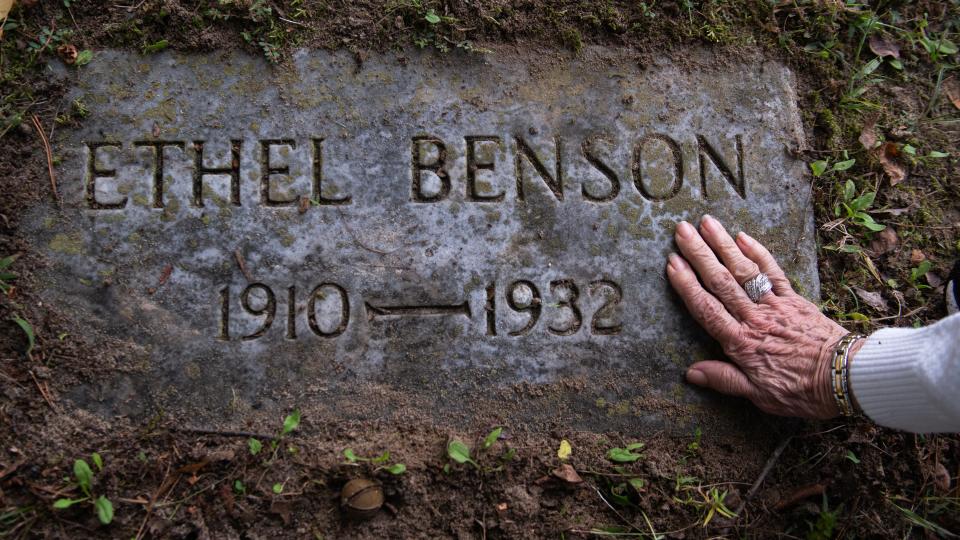
Delaware's role in the country's eugenics movement, from which Adolf Hitler and Nazi Germany used as a model, has often been relegated to a footnote in this chapter of American history.
An estimated 70,000 Americans were forcibly sterilized in the 20th century. States like California, North Carolina and Virginia often take the focus due to the sheer number of procedures, even though Delaware’s rate of sterilization regularly outpaced them, according to an analysis by Delaware Online/The News Journal.
'Strong Black woman' myth: This is hurting the mental health of African American women, author says
Doctors and politicians, relying on now considered junk science, convinced lawmakers that sterilization would improve and protect society. Sexually active single women soon became a target.
Those sterilized in Delaware were deemed unfit mothers, or girls who had premarital sex. Sometimes, they were both. Others were epileptic or misbehaving boys. Some were criminals. Though estimates indicate operations overall were evenly split between men and women, the state was sterilizing women more frequently in the later years of the program, reports show.
One Black girl was as young as 11 years old.
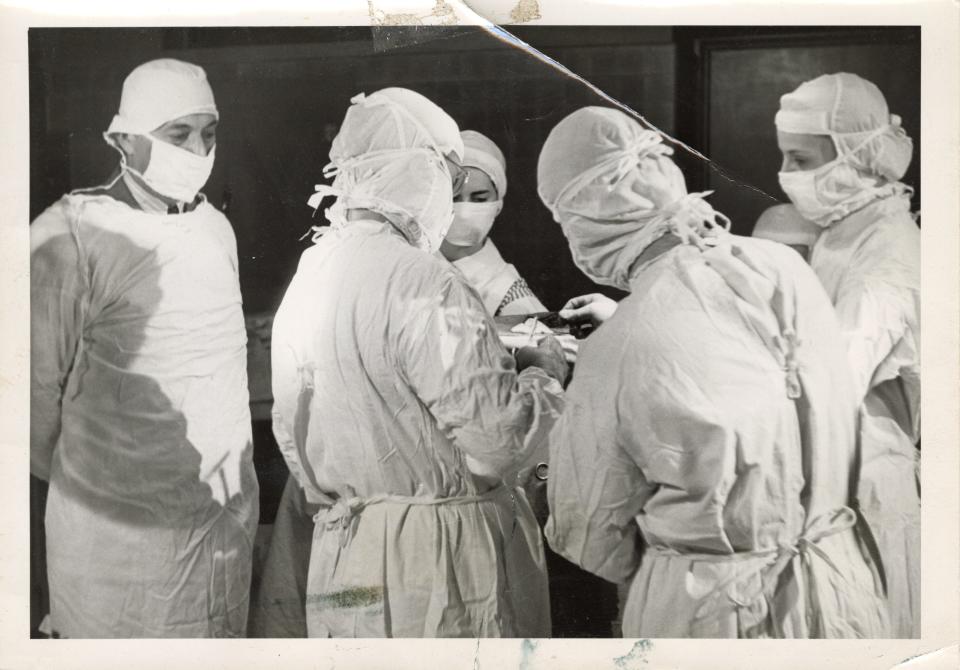
“The harm that one feeble minded mother can do in the world is almost impossible to estimate,” a 1923 Delaware report reads.
They often were first institutionalized at the Delaware State Hospital or Delaware Colony. When a three-person board approved these procedures, families rarely had a viable chance to fight it – if they were even told at all. For decades, there was no due process.
Delaware has never formally apologized for sterilizing upwards of likely 1,500 people. It wasn’t until this fall that involuntary sterilizations were repealed from state law.
THE BACKSTORY: How this reporter uncovered Delaware's forgotten history of forced sterilizations
Some of the children of the women who were forcibly sterilized still live in the Delaware area. Being away from their mothers left a hole in their lives, explained one daughter whose mother was sterilized in the 1950s due to being a “procreative menace.”
Ethel's daughter lived a lonely childhood, one that wasn’t filled with many friends. She stuck out in the family due to her light skin. Some relatives refused to adopt her for that reason.
As a girl, she overheard her uncle cuss about what those sonsabitches did to her mother, who the family often described as “handicapped.” Ethel’s striking beauty was a constant topic of discussion among the family, even from an aunt, who was not the complimenting type.
That poor child, they would tell Ethel’s daughter, didn’t know any better.
The birth of eugenics and the Delaware doctor who championed it
A young Russian physician stepped off the train in Farnhurst, Delaware in the spring of 1918. Aided by his cane, Dr. Mesrop Alexis Tarumianz, walked the quarter mile to Delaware State Hospital in New Castle.
Just 33 at the time, Tarumianz was a man without a home. He was born into an “ill-fated wealth and position in Czarist Russia,” The News Journal would later recall. World War I left him injured when a German shrapnel shell exploded near the young Imperial Army of Russia medical officer.
Now, here he was in America to reunite with his German wife, a trained pianist who taught music.
As he stepped inside the hospital, the doctor was quickly disgusted with what he saw around him. The hospital, according to reports, housed 650 patients. The conditions were deplorable. Close to 100 people slept in wooden cages and straw mattresses.
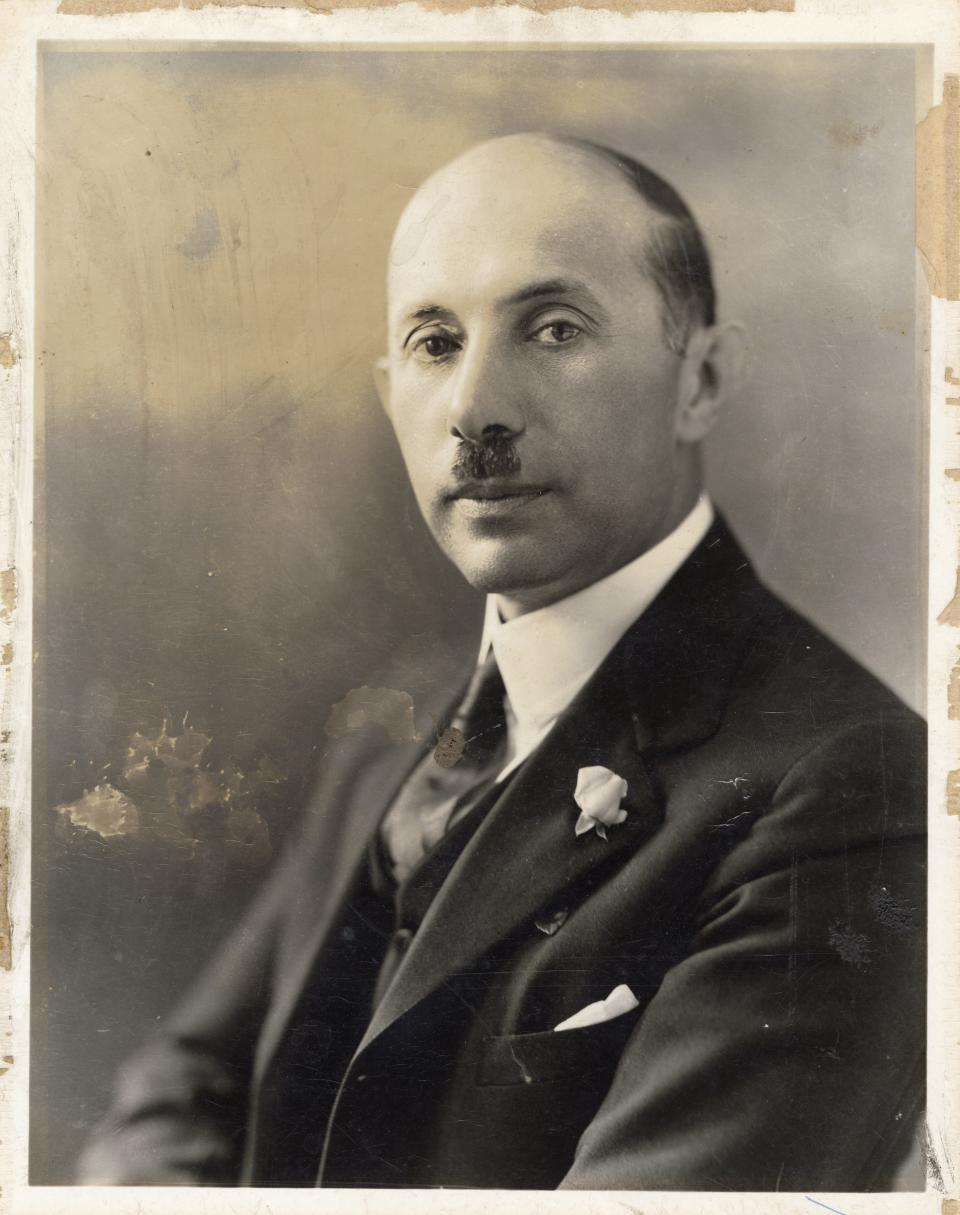
Delaware was considered a pioneer in caring for the mentally ill. In 1889, the legislature authorized money to build a State Hospital for the Insane, becoming the first state to do so. The mentally ill were previously relegated to county poorhouses or almshouses, where men could be found chained to the floor. Those deemed seriously troubled were sent to hospitals or institutions in neighboring states.
The birth of eugenics came as the country entered the 20th century, a time when immigrants came to America for new beginnings and some forms of birth control began to be accessible, said Johanna Schoen, a Rutgers University professor who researches the history of reproductive rights and eugenic sterilization.
Both threatened the idea that the United States was dominated by a white, native population. Eugenicists soon helped influence the passage of legislation that restricted marriage, controlled immigration and legalized forced sterilization.
One of the earliest supporters of eugenics in Delaware was Dr. Martin Barr, a physician who served as the superintendent for the Pennsylvania Training School for the Feeble-Minded in the early 20th century.
In 1905, he authored the country’s first bill allowing the government to sterilize the “mentally deficient,” according to his obituary. It passed the Pennsylvania legislature that year but was struck down by the governor. (Indiana, two years later, became the first state to successfully pass similar legislation).
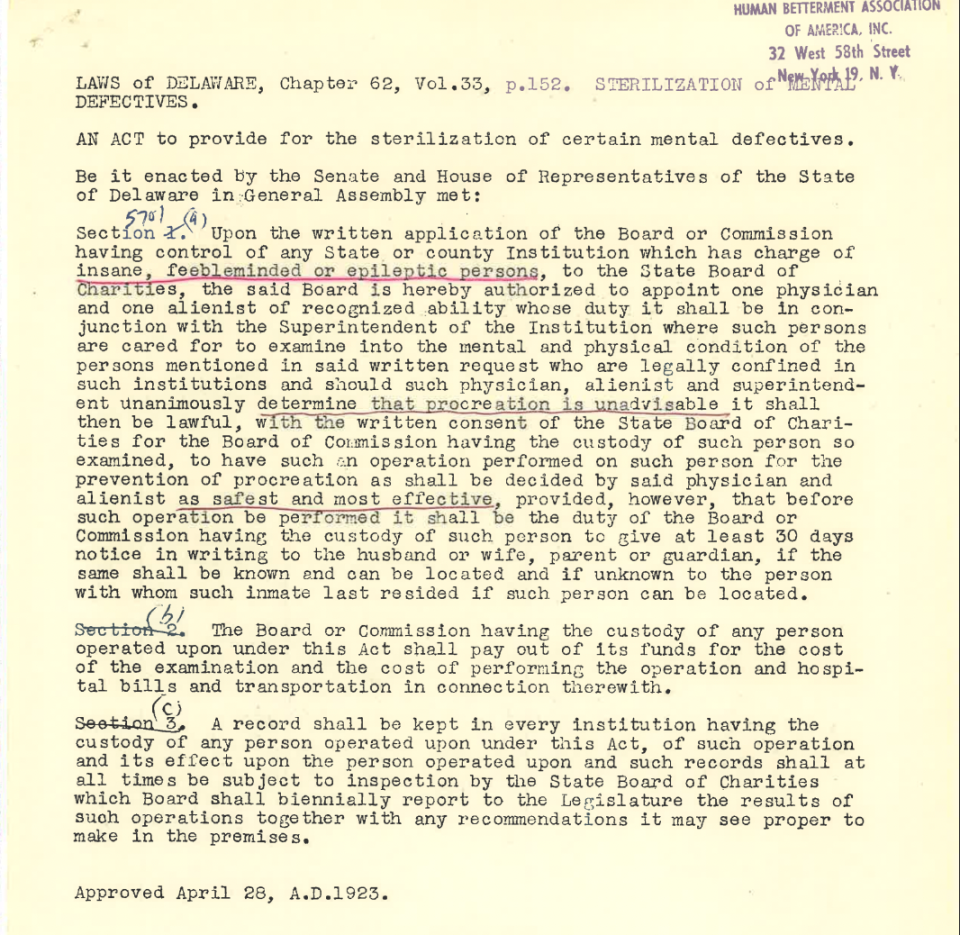
This didn’t discourage Barr. He traveled the country to spread the word about sterilization. He was among those who campaigned Delaware to open its own mental institution for the feebleminded. Barr, years later, was influential in determining who was forcibly sterilized.
By 1921, the Delaware Colony for the Feeble Minded prepared to open its doors in Georgetown.
Not long after, the State Board of Charities began to actively consider sterilization. The first procedures were conducted in Pennsylvania in 1922 among four Delaware young people. Some state reports referred to them as children. The board became convinced that sterilizations worked, noting that state officials found them now “docile and easy to care for,” according to a 1926 state report.
There was, in the board’s view, no more important issue for lawmakers to vote on. In the spring of 1923, Delaware passed a compulsory sterilization law.
The procedures began slowly, with only a handful occurring in the early years. Eugenicists throughout the United States were empowered to charge ahead following the pivotal Buck v. Bell decision in 1927, now considered one of the U.S. Supreme Court’s most egregious rulings.
The court ruled that it was in the best interest of the Commonwealth of Virginia to sterilize Carrie Buck. The girl, who gave birth to a child after being raped at age 17, was deemed feebleminded. Just like her mother, Buck was committed to the Virginia State Colony for Epileptics and Feebleminded.
In his opinion, Justice Oliver Wendell Holmes wrote the famous words: “Three generations of imbeciles are enough." The court upheld state-enforced sterilization.
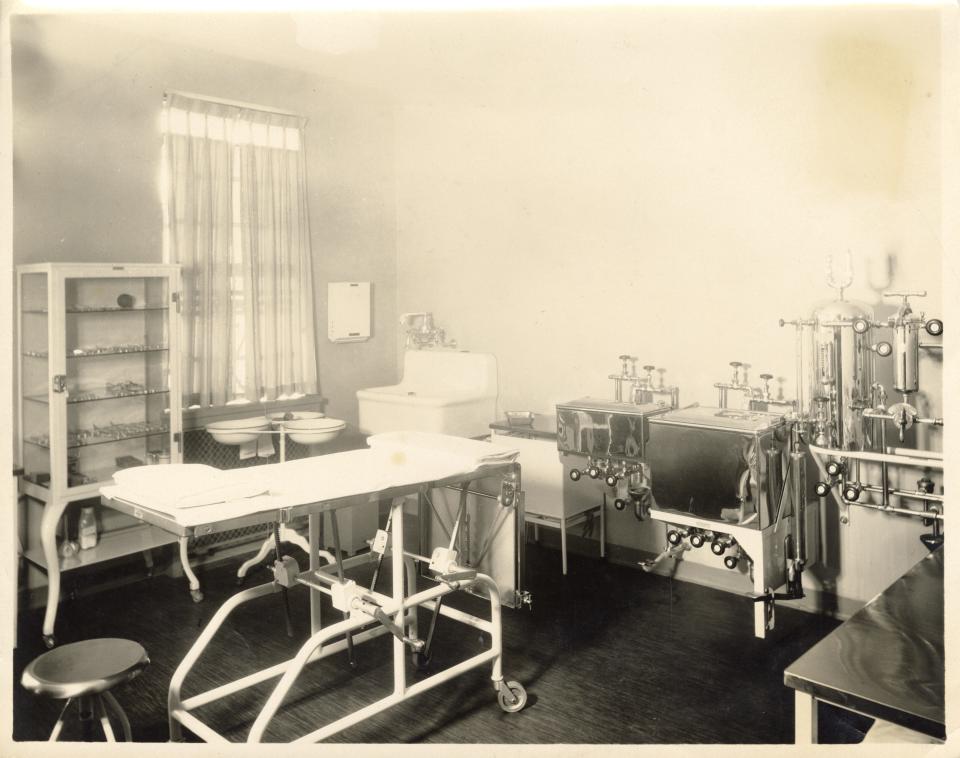
Tarumainz, known for his signature carnation boutonniere and toothbrush mustache, climbed the ranks in Delaware by this time. Though he initially wanted to quit the state hospital, he became its superintendent in 1926 and oversaw the state’s mental health programs for decades.
He became one of the most ardent supporters of eugenics and sterilization. He lobbied lawmakers in 1923 and continued to publicly support this measure for decades, state officials would later recall.
Tarumainz likely recommended hundreds of people to be sterilized.
“We must face the fact,” Tarumianz said in a 1928 speech to the Rotary Club Wilmington, “that the nation is being poisoned by the rapid production of mental and moral defectives, and to insure the survival of the fittest, we have to abrogate such defectives of all power to procreate.”
Delaware aggressively updated its sterilization law in 1929 to allow the state to forcibly sterilize more people – this meant felons, epileptics, anyone seen with mental illness, gay men and promiscuous women.
That same year, Ethel gave birth to her first child.
'The women wanted her dead or go somewhere else'
Ethel was born in Delaware in 1910, the youngest child. The family lived in Burrsville, a small village situated on the Delaware-Maryland border, just five miles from Denton, Maryland.
At a time when Jim Crow laws terrorized Delaware, the Bensons, Ethel’s daughter recalls, were among only two or three Black families who lived in the town.
Daniel, Ethel’s father, could neither read nor write. Ethel was also illiterate, census records show. The family, years later, described Ethel to be “slow” or “handicapped.” Her mother, Rachael, died sometime before 1930.
When the Great Depression torpedoed the American economy in 1930, Daniel was able to maintain work, toiling away at a nearby sawmill. Widowed by then, a woman named Georgie Bell came into his life.
She is listed in the 1930 census as a servant, but Ethel’s daughter knew her as Daniel’s girlfriend. When she speaks of Georgie decades later, her voice becomes quiet and cold.
“Pop would have to go to work,” Ethel’s daughter explained. “And he would leave Ethel home with Miss Georgie. And she would let men come in there and have their way with her.”
These men spotted Ethel, her daughter said, when they worked in the fields or when she was sent down to the stream to fetch water. She believes her mother was easily led – and that these sexual relationships were not consensual.
“She had no control,” her daughter said. “If a man wanted to use her, he would use her. She’s not going to say ‘No, don’t touch me.’ And he’s not going to do it.’”
Ethel gave birth to her first child, a boy they called Clarence, in 1929. The father was a white car salesman, her daughter said. That summer, Ethel became pregnant again.
Her daughter was born in April 1930. The father was a member of a white, prominent farming family in Delaware, the daughter was told years later. By this time, she explained, the town of Burrsville was taking notice – particularly the white women. They soon confronted Daniel about his daughter.
“The women wanted her dead or go somewhere else,” Ethel’s daughter said.
The model, throughout the county, had become to institutionalize people who were problems to the greater society, sterilize them and then release them back into the community.
Though many people in these situations were classified as “feebleminded,” it was an undefined, “grab bag” legal phrase. It often applied to women seen as promiscuous, said Paul Lombardo, a Georgia State University law professor who has written extensively on sterilization.
“The argument is, ‘We're doing good things. This is the moral thing to do. We're cleaning up society,” Lombardo said.
It was a financial decision too, he said. Politicians, including those in Delaware, saw forced sterilizations as a way to reduce the cost of institutionalizing because it allowed people to be discharged more quickly. In 1927, state officials said sterilizations have allowed Delaware to save $400 a patient, The News Journal reported.
Ethel was admitted to Delaware Colony on Aug. 6, 1930. When doctors examined her, they determined her mental age was that of a six-year-old girl, according to the few documents about Ethel that exist at the Delaware Public Archives. She was among the two dozen Black women admitted at the time.
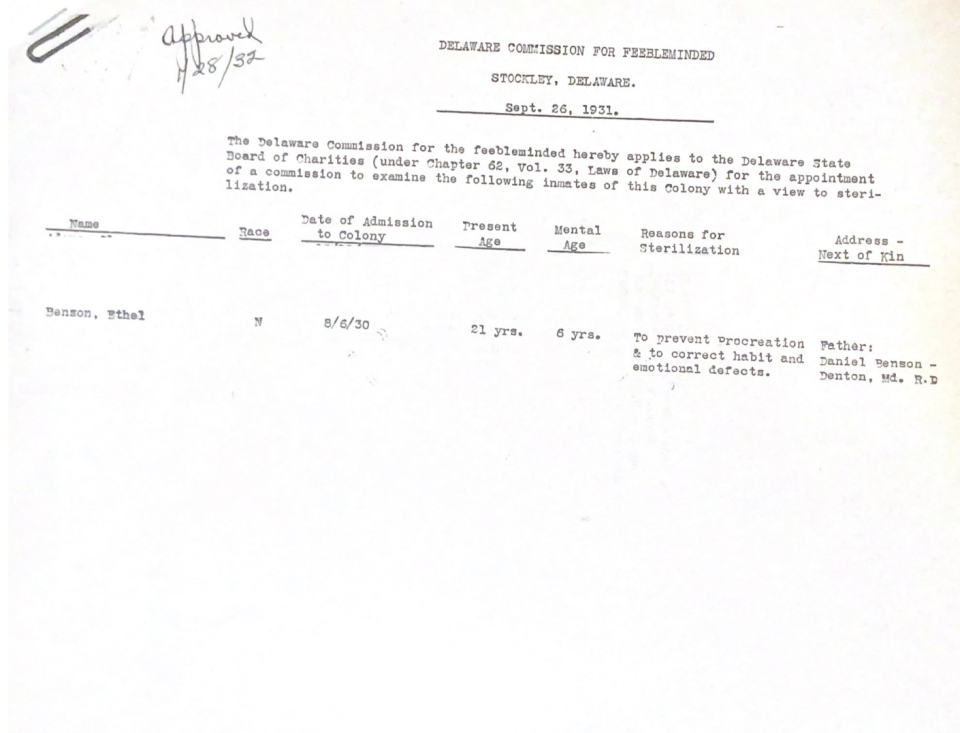
The Delaware Commission for Feeble Minded filed an application for Ethel’s sterilization after she was living there for about one year. The purpose: “To prevent procreation & to correct habit and emotional defects.”
The State Board of Charities, later the Department of Public Welfare, oversaw the sterilization applications. The application was usually first made by the superintendent of the institution where the person was confined. In other cases, it was based on a recommendation made by the state hospital’s mental hygiene clinic, which Tarumianz ran.
Then the state board appointed a three-person commission: A physician, a psychiatrist and the superintendent who first filed the application. All white men.
The commission’s recommendation needed to be unanimous. And if it was, the men then requested the department to carry out the procedure. An analysis of state reports shows an overwhelming majority of sterilization applications were approved.
As Ethel waited for this procedure, it's likely she lived with the other Black girls and women in Houston Hall, one of the five Delaware Colony buildings that faced significant overcrowding. A 1931 state report detailed how the building was depressing. The plumbing was poor. The kitchen and the dining room, located in the basement, were dark and dingy.
The Black residents were segregated from the white residents until the mid-1950s and lived in often worse conditions. They received the ragged hand-me-downs of their white peers, said Linda Fleetwood, a Stockley Center volunteer who curated a museum of the institution’s history.
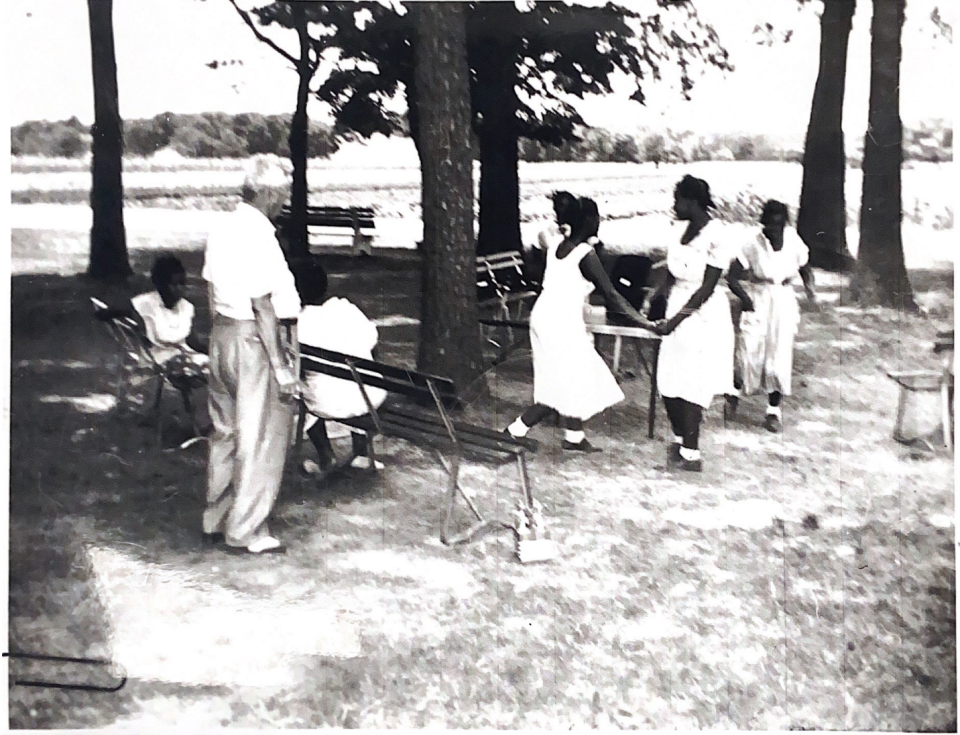
Fleetwood found documentation on how Black residents were forced to eat their meals as sewage leaked around them.
By January 1932, Ethel’s sterilization procedure was approved. There is no mention in the documents on whether the Benson family was ever informed.
(Ethel’s daughter has questioned aspects of the timeline laid out in the existing records. She was under the impression her mother was at Delaware Colony for a matter of weeks – not two years – a reminder of how little remains known about what happened to those institutionalized in Delaware.)
Delaware law technically gave families 30 days' notice about the procedure. A 1926 state report recalled how, of nearly 50 procedures approved that year, “only one relative objected, but after full explanation she withdrew her objections.”
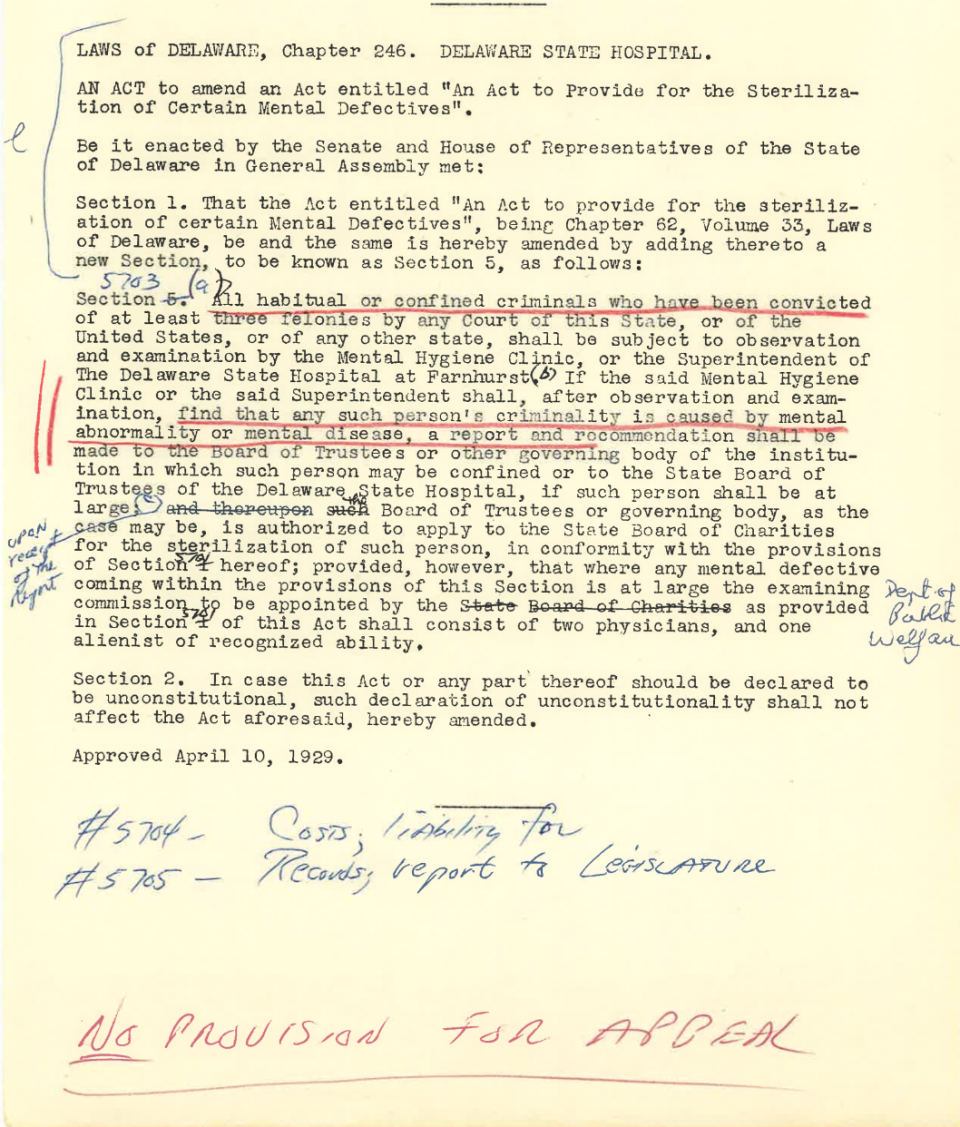
Even if these families did object, it didn’t do much. Delaware did not have any type of judicial review or appeal process.
In 1965, a Walter Reed Army Institute of Research political scientist wrote a now-celebrated report on every state’s sterilization practices. When Julius Paul researched Delaware, he found state officials had differing opinions on whether an appeal process even existed.
“Outside of the 30 days’ notice (which is ironic since it is worthless if it cannot be followed by objections and a possible appeal to higher authority),” Paul wrote, “there is nothing in present law that remotely resembles due process of law.”
A Delaware Catholic priest, in a 1969 letter to then-News Journal reporter Bill Frank, wrote how parents were “helpless” if sterilization was recommended. The priest, in the letter, said he worked for the Catholic Welfare Guild (now Catholic Charities) from 1938 to 1956. The Catholic Church, throughout the eugenics movement, was adamantly against sterilization.
“In those days,” he wrote, “rarely was anyone ever discharged from Stockley without first being sterilized.”
The Beebe brothers' role in sterilizing Delaware residents
Ethel was sterilized at Beebe Hospital on Nov. 15, 1932.
For most women, sterilization meant undergoing abdominal surgery in order to remove one or both of their fallopian tubes, said Schoen, the Rutgers professor. These procedures occurred before antibiotics were widely available.
Eight days after the surgery, Ethel began to experience complications, according to the death certificate. She died in the early morning of Dec. 16, 1932 and she was buried in the Delaware Colony cemetery three days later. She was 22.
Her death certificate was signed by Dr. James Beebe, founder of Beebe Hospital and the surgeon who performed the sterilization.
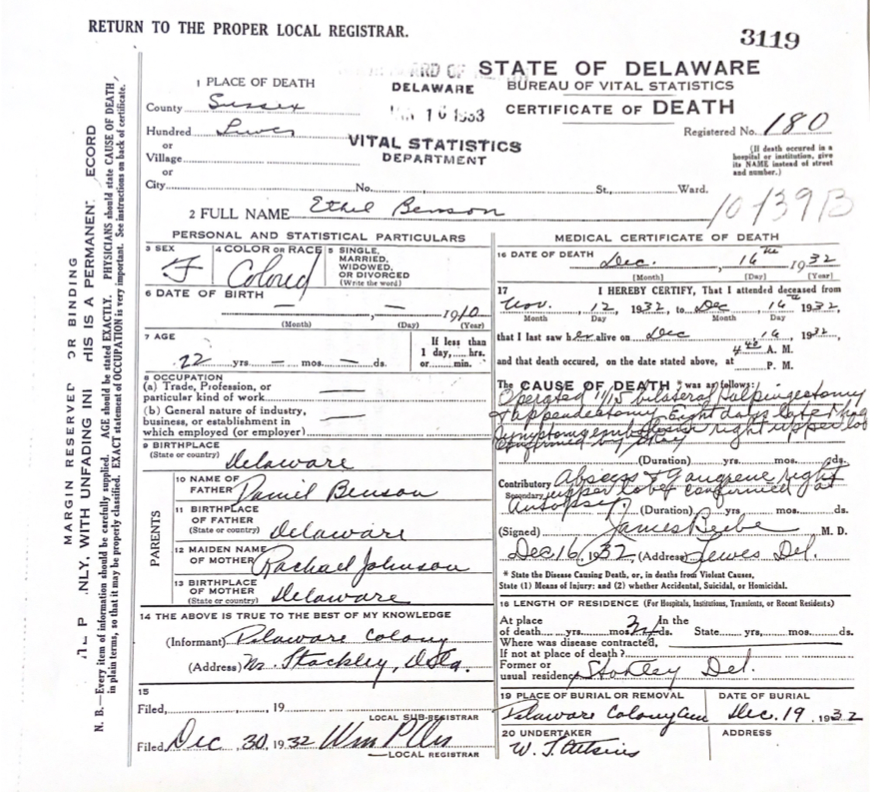
From 1929 to 1938, Beebe Hospital performed 182 sterilization procedures, according to a record of operations book.
It was just about 8% of the total surgeries done in this time period, according to Delaware Online/The News Journal analysis, with Dr. James Beebe performing almost half of the sterilizations. Dr. Richard Beebe, who helped found the hospital with his older brother, performed about 20% of the operations.
Doctors at this time, said Schoen, the Rutgers professor, “genuinely thought that that was the best course of action.”
“But I don't think that that really excuses anything,” she added.
It’s clear, as documented in newspaper clips, that Delaware Colony had a relationship with Beebe Hospital very early on. For years, it was one of the few hospitals in the area. When comparing census records, almost half of the patients sterilized were identified as “inmates” of Delaware Colony.
Minutes from a 1924 State Board of Charities meeting, which oversaw sterilizations in Delaware, named Dr. Richard Beebe as one of the rotating three physicians to examine the sterilization applications.
Many of those sterilized at Beebe in 1929, according to the records book, were given the diagnosis of both “mental incompetency” and “exaggerated sexual tendencies.” In later years, the diagnosis was solely “mental incompetency.”
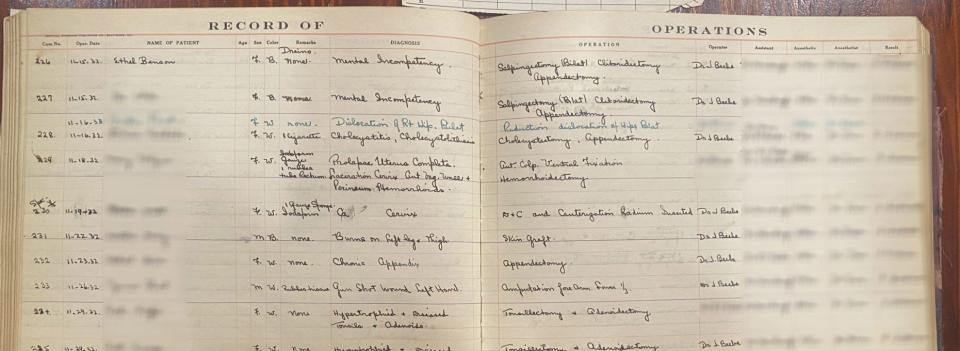
More women were sterilized than men, with almost every male patient undergoing a vasectomy, according to the records book. In three cases, castration was recorded.
Black men and women made up 20% of the sterilizations, despite making up about 13% of the population in 1930, according to census data.
Though white women greatly outnumbered Black women in sterilization procedures, Black women were more likely to be listed as having clitorectomies than white women. Ethel Benson was one of these women.
The News Journal could not find records showing if the Beebe brothers continued performing sterilization procedures after 1938. Records, found in the state archives, noted how three women were sterilized at Beebe Hospital in the early 1950s.
Dr. James Beebe, Jr. in 1955 was named a consulting surgeon for the facility. However, Delaware Online/The News Journal did not find information showing he performed any sterilization procedures.
The News Journal could also not find records or newspaper articles in which anyone in the Beebe family made public statements about eugenics or sterilization. Delaware Online/The News Journal sent Beebe Hospital its findings on the sterilization procedures performed by the Beebe brothers.
“Throughout our country’s history, progress has driven us to evolve as a society,” a hospital spokesman said in a statement. “Medicine has made great advancements – technologically and ethically. History is a part of our civilization and marks where we have come from. Now, more than 3,000 talented and skilled Beebe team members proudly care for our community by providing advanced and innovative healthcare to our Sussex County community.
“This is what Drs. James and Richard Beebe sought to do by the standards of their time more than 100 years ago. Beebe is proud to continue advancing the practice of medicine for the generations to come.”
Nationally, physicians were among the most vocal supporters for eugenics programs.
In December 1933, almost one year after Ethel died, Tarumianz, the leading state psychiatrist and superintendent of the state hospital, boasted how Delaware had one of the best sterilization laws “set up anywhere.”
The News Journal reported at the time that Delaware had performed more than 350 sterilizations since 1923, about 150 of which were among those at Delaware Colony. The article, in the second paragraph, noted: “This information is significant in view of the activities of the Hitler regime advocating the sterilization of the unfit.”
But this mention of Hitler likely wouldn’t have offended Tarumianz at the time.
“To Germany must be given the credit of being the first country which has realized the importance of a general eugenics law,” he wrote in the May 1934 edition of the Delaware State Medical Journal.
“Although at present it has received rather unpleasant notoriety, it is a step forward in an attempt to improve the race and will undoubtedly be accepted as such after the first excitement has subsided.”
The forgotten women of Delaware Colony
Mabel was a bit tense. She wanted the doctor in the Georgetown clinic to like her, so she proudly spoke about her job vaccinating chickens. She had saved almost $50 so far.
Tarumianz was the psychiatrist examining her. He noted how her white skin was dirty, same with the overalls she was wearing. She also smelled. He didn’t find her to be particularly confident. She couldn’t read signs or do simple math.
It was the spring of 1944 and the 22-year-old knew she was pregnant. But she was not sure of when she was due. There was this man, and he was in the Army. He just left for Massachusetts, Mabel explained, but he had written her 75 letters. He promised marriage.
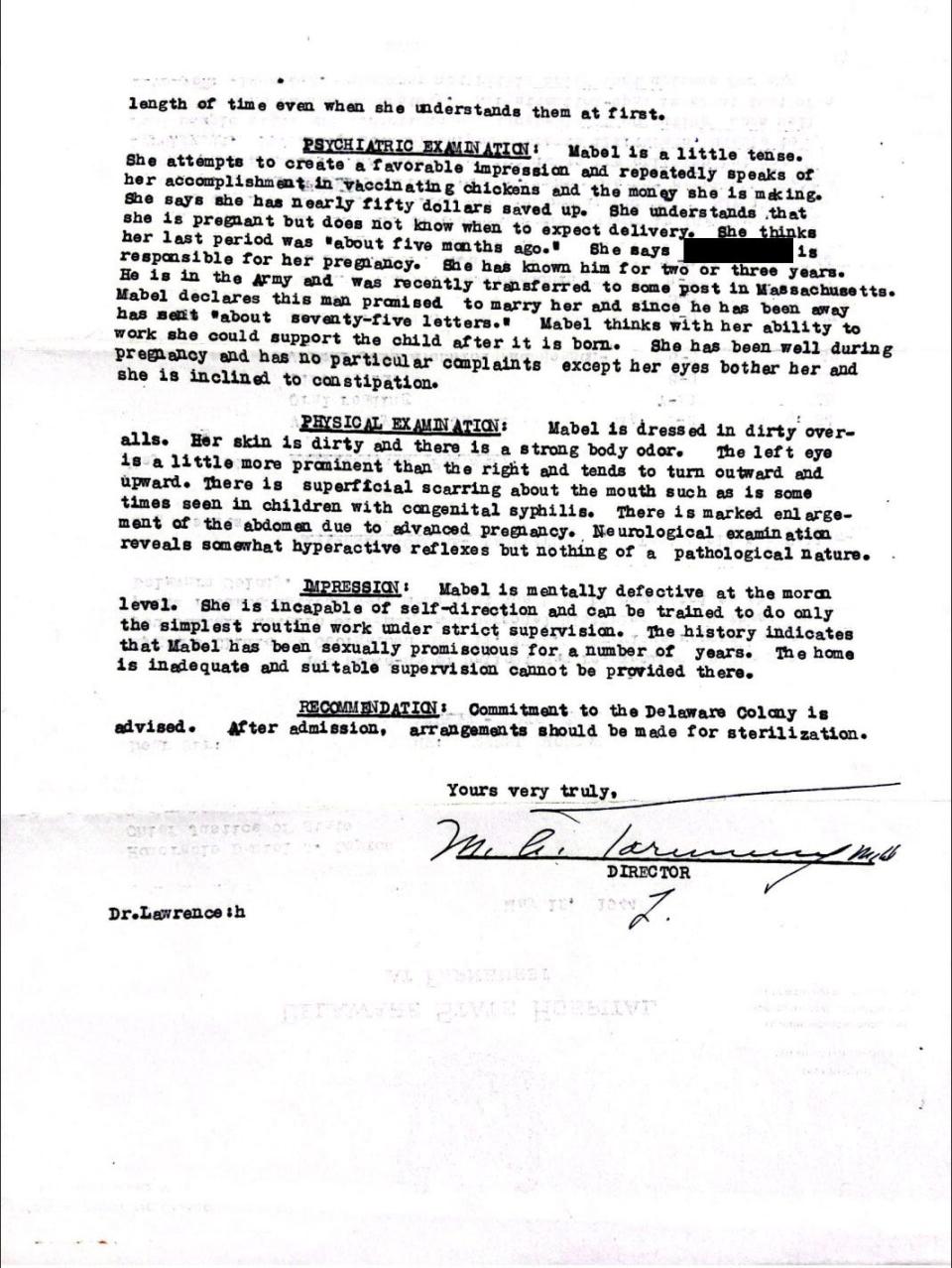
What Mabel likely thought of as a love story, the people in her community of Bethany Beach viewed as an immoral travesty. She was “sexually delinquent” and a “menace” to the soldiers stationed nearby, according to her report.
“Commitment to Delaware Colony is advised,” Tarumianz recommended. “After admission, arrangements should be made for sterilization.”
In 1944, Delaware had the highest rate of sterilization in the country, kicking off a two-decade run of regularly surpassing states like North Carolina, Utah and California, according to News Journal analysis.
From 1923 to 1963, Delaware performed an estimated 945 sterilizations, according to the report by the Walter Reed Army Institute of Research. Sterilizations continued in the 1970s, according to newspaper clips.
Delaware Online/The News Journal reviewed documents at the Delaware Public Archives, which included petitions and reports recommending about three dozen men and women be institutionalized in Delaware Colony. Not all records were available for review due to confidentiality rules. This news organization is not fully naming Delawareans identified in these reports.
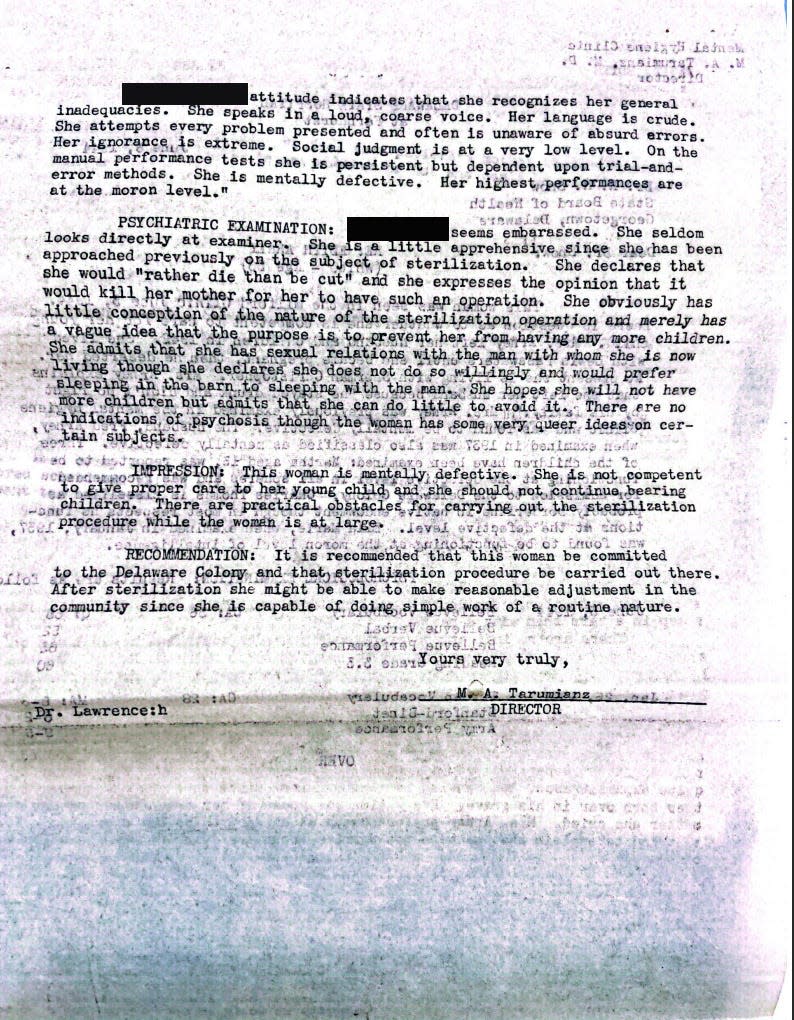
Almost all of the women in these documents were viewed to be promiscuous, social menaces or unfit mothers who failed to properly take care of their children. Men were also recommended for sterilization.
Some states, in the wake of World War II, shut down their eugenics programs. Yet Delaware’s program continued for two decades, having the highest rates in the country at various points after the war ended up until the early 1960s. The state’s rate of sterilization was its highest in 1948.
Women like Edith, of Greenwood, adamantly told state officials in 1944 they did not want to be sterilized.
The state questioned, in its psychiatric report of her, if she was a competent mother. She had left her husband and her children in 1942. The husband was a drunk who “didn’t do right by his family,” she explained.
She met another man, got pregnant and then he deserted her.
Edith worked as a housekeeper. The 36-year-old told doctors she was sleeping with the man who owned the home. But she did not do so willingly, she told doctors. She said she’d “prefer sleeping in the barn to sleeping with the man,” the report reads.
When doctors mentioned sterilization, Edith declared “she would ‘rather die than be cut.’”
Still, Tarumianz recommended Edith for sterilization. She was committed to Stockley in 1945.
In the documents available at the Delaware Public Archives, The News Journal was only able to find one woman who expressed interest in getting sterilized.
Beginning in the 1950s, the Delaware legislature proposed bills well into the 1960s that would have required an unwed mother to be sterilized in order to receive welfare payments. Lawmakers, both Democrats and Republicans, viewed this as the solution to curb public welfare costs and discourage “further illegitimacy.”
In 1955, the superintendent of Delaware Colony told lawmakers in a budget hearing that sterilization procedures had been temporarily paused – because it hadn’t changed the “incidence of mental deficiency.” There were no sterilizations in 1954 or 1955, according to state data.
Dr. Pasquale Buoniconto spoke of “the great change of opinion about sterilization” and how some states are against it altogether. But this pause didn’t last long. Buoniconto resigned after serving in the role for 17 months.
Tarumuniaz, the fiercest proponent of sterilization, then became superintendent, in addition to his role of leading the state hospital. Sterilizations began again. Delaware Colony was renamed to the Hospital for the Mentally Retarded.
One of the women sterilized around this time was a 25-year-old Black woman named Rosetta. She had six children, the oldest of whom was 10 years old.

She was described as a feebleminded person who “continues to be a procreative menace to the social and moral welfare of her community,” according to the few public records that still exist. The state did not view her as capable of caring for her children.
Tarumianz examined her and later testified that she should be sent to Delaware Colony.
Rosetta’s oldest daughter, who still lives in Delaware, said her mother had a bout of nerves. Back then, her mother couldn’t seem to stop crying. Her daughter asked The News Journal to not publish her and her mother’s full name since younger members of their family do not know about Rosetta being sterilized.
In documents, it appears witnesses tried to testify against Tarumianz’s recommendation of sterilization. Maybe it was Rosetta’s mother or three sisters. But it didn’t work. She was institutionalized in September 1955.
When Rosetta left home, so did her children. The youngest was just a baby. They were separated from their family, being carted to two different foster families. The oldest daughter remembers the hand-me-down clothes and the toys she was allowed to look at but not touch.
The children were eventually reunited with their aunts and grandmother. She remembers being told that in order for her mother to leave, “she needed to be fixed” – or sterilized.
Rosetta’s daughter is firm when thinking that her mother would have done anything to get home to her children. But she also believes it’s likely that, as a woman with a 3rd-grade education, she didn’t fully understand what it meant to be sterilized.
It’s not clear what year Rosetta was sterilized or discharged from Stockley as The News Journal could not find those records.
When Rosetta finally returned home, her daughter said she acted “normal.” She never had a nervous breakdown again. She found the church, which soon became her anchor. She sang in the choir and visited the sick. But she never talked about that period of her life.
Looking back, Rosetta’s daughter said there was a deep void in her life when her mother was away.
“I didn't have a mother to lay in her arms,” she said.
A return to Burrsville and Delaware's history
Ethel Benson’s daughter returned in 1950 to the town that banished her mother. She was 20 years old, the same as Ethel when she left. Burrsville was still the rutted downtown that she remembered.
She figured everyone in town knew who she was since it was small enough for everyone to know everyone else’s business. But she said she didn’t have any fear.
“I had a husband,” she said. “I had a Black husband. He was good-looking. He had a good reputation. You can’t touch this.”
“I strutted around like a peacock,” she said.
Shortly after her mother died, her grandfather gave her to another couple, who she later learned were drunks. She was eventually raised in Denton, Maryland by her Uncle Clarence’s wife’s sister Nettie.
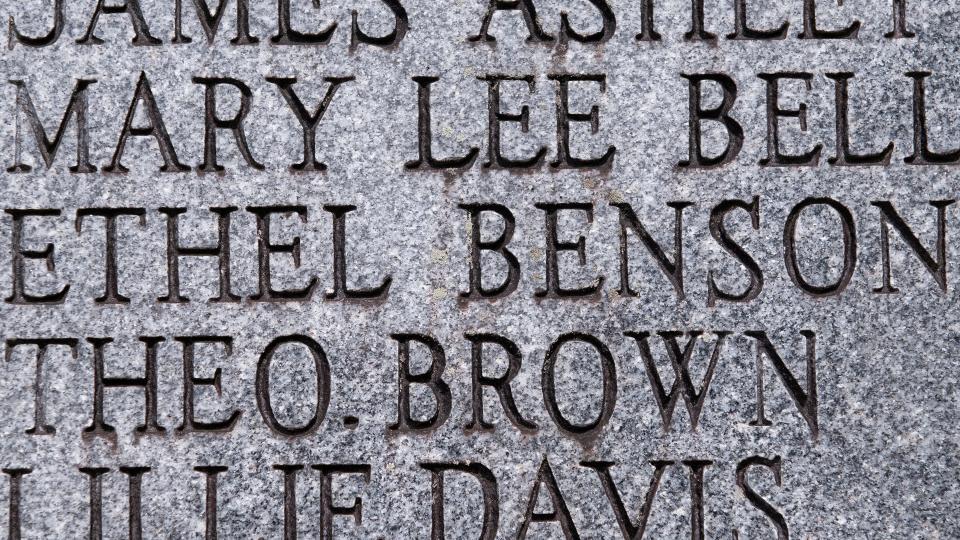
She was often teased for not having a mother. And she hated her grandfather for as long as she could remember. She visited him twice when she was young, never saying a word to him. She just glared.
Though he gave his granddaughter up, Daniel Benson decided to keep his grandson, likely because he was a boy. Ethel’s daughter said she never had a relationship with her brother.
“Nobody wanted me,” she said. “It wasn’t his fault, but I didn’t like him because of it.”
When she was 18 years old, she was accepted to Hampton University but decided not to go. She had just met her husband and wanted to live her life as a wife and mother. She viewed returning to Burrsville as her way of showing the town that she survived and she wasn’t “retarded.”
As she settled into motherhood, the practices at the Hospital for the Mentally Retarded were being criticized for the first time.
A 1963 report by the American Psychiatric Association found that state’s mental health institutions were “suffering from schizophrenic administration, aggravated by obsolescence, under staffing, legal confusion, pockets of staff dissatisfaction, overcentralization and a research and training gap.”
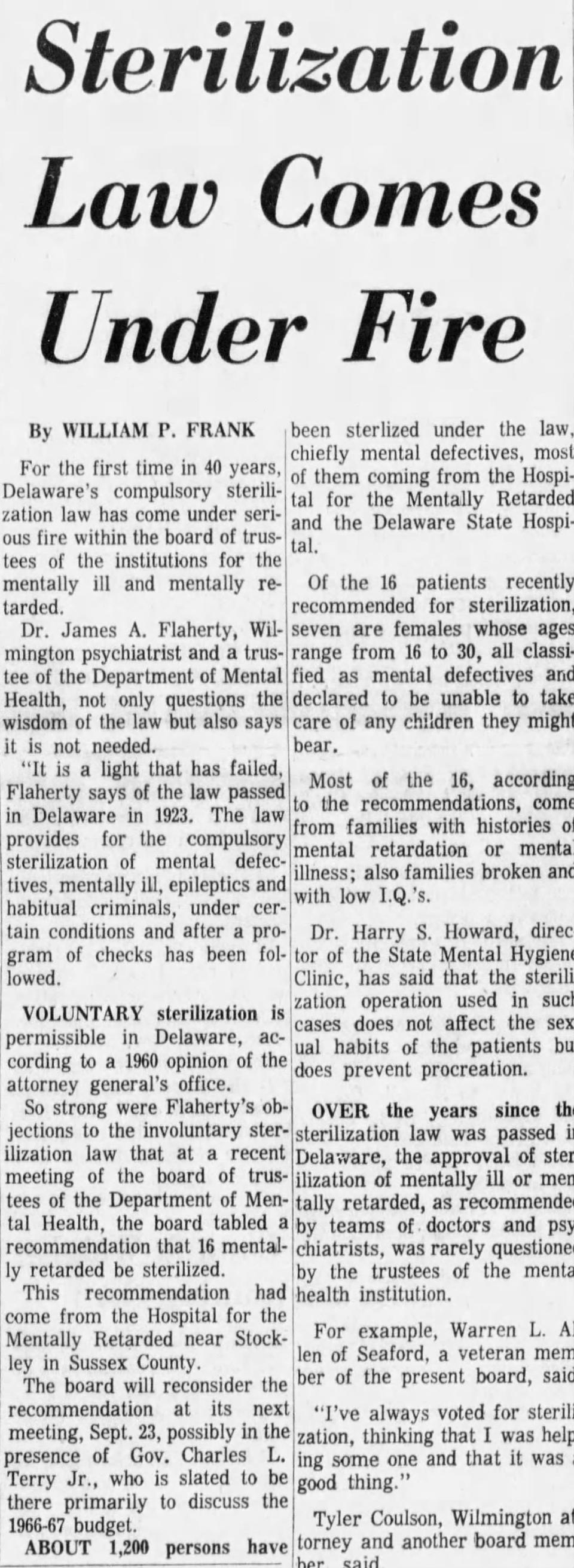
State officials in the then-Department of Mental Health began to publicly question the sterilization program in 1965 for the first time in decades. This debate continued into the 1970s, with calls to repeal the law continuing to grow louder.
The News Journal reported in 1971 that Delaware had sterilized 1,500 people. It’s not clear when Delaware stopped sterilizing residents at either the state hospital or mental institution. The paper reported in 1978 that “five young women have undergone involuntary sterilization” since 1975.
By 1985, Herman Holloway, the first Black state senator in Delaware, led the charge in updating the sterilization law, with fellow critics arguing it was unconstitutional. It changed language around consent and eliminated references to epileptics and felons being eligible for involuntary sterilization. The Chancery Court would now need to first approve any involuntary sterilizations.
The last involuntary sterilization The News Journal could find was ordered in 1996. A 15-year-old girl named Susan had severe autism and was nonverbal. She harmed herself when she was menstruating. Her parents petitioned for her to undergo a partial hysterectomy, which was approved.
The law for involuntary sterilization remained in Delaware code for 100 years – until this fall.
'Of all god’s children these are the most innocent'
She hadn’t thought much about her mother’s grave, even the sheer existence of it. Instead, ever since she was a little girl, Ethel's daughter craved to see what her mother looked like.
She knew her mother had light skin and a rosebud-shaped mouth. Her bare lips, people told her, always looked like they had lipstick on. Did the mother and daughter look alike?
In September 2021, she visited her mother’s grave for the first time in 90 years. Ethel Benson’s daughter was joined by her own daughter, who had made the request to visit for her birthday.
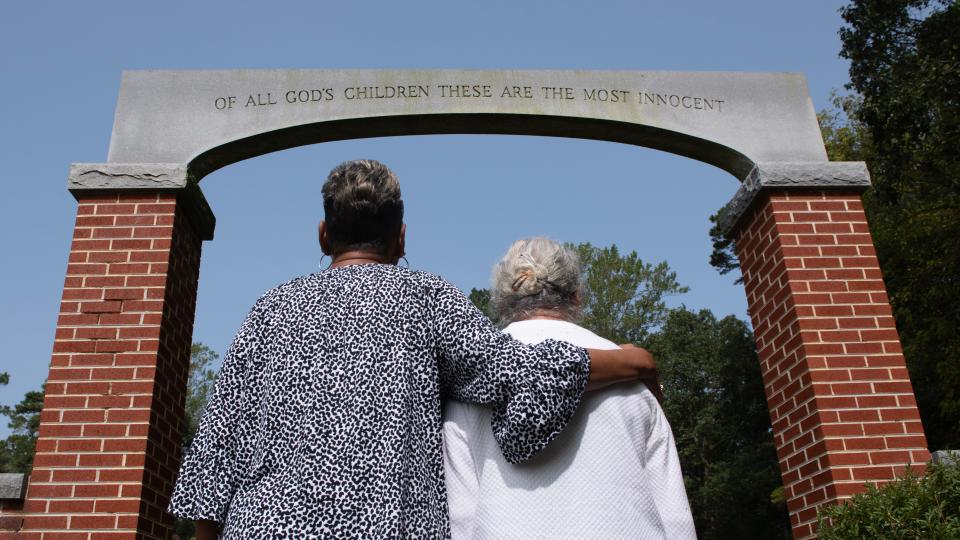
The Georgetown cemetery is tucked in a quiet area where the woods border its edges. It’s on the sprawling grounds of the long-term care facility, which was renamed to Stockley Center. The facility has a census of about 41 people, caring for those with intellectual and developmental disabilities.
The stepson of Fleetwood, the museum curator, has lived at Stockley for about two decades. She previously told The News Journal that “as I have a breath in my body, my stepson will be here."
“Those who work there,” she said recently, “are caring, loving people, who protect those residents like they’re their own.”
This June, lawmakers introduced and passed a bill that repealed all Delaware code related to involuntary sterilizations. It was part of a larger bill to update language relating to behavioral health. It was signed into law by Gov. John Carney last month.
Joe Aronson, a health department official, said before Senate lawmakers that it was important to acknowledge the connection to eugenics and the “harm” it caused for “minority, marginalized and stigmatized communities.”
Forced sterilization continues to remain legal throughout the country. A 2022 report by the National Women’s Law Center found that 31 states at the time, which then included Delaware, had laws allowing forced sterilization of disabled people.
States including California, Virginia and North Carolina have formally apologized and created a reparations program for victims, which have had varying success.
Schoen, the Rutgers professor, said it’s important for states to acknowledge and apologize for “coercive policies” in order to fully reflect on what it means for current-day reproductive health care access.
“It's not like we today live in a society,” Schoen said, “where we trust women to make reproductive decisions and so hopefully, it's part of a larger conversation about: What happens when you don't trust women? And what happens when reproductive health care is not available?
“And what happens with people like (Ethel Benson)?”
Ethel’s daughter had a happy marriage to a husband who died years ago. She still lives in the small home where she raised her two children. At 93, she does her own yard work and has taken in a stray cat.
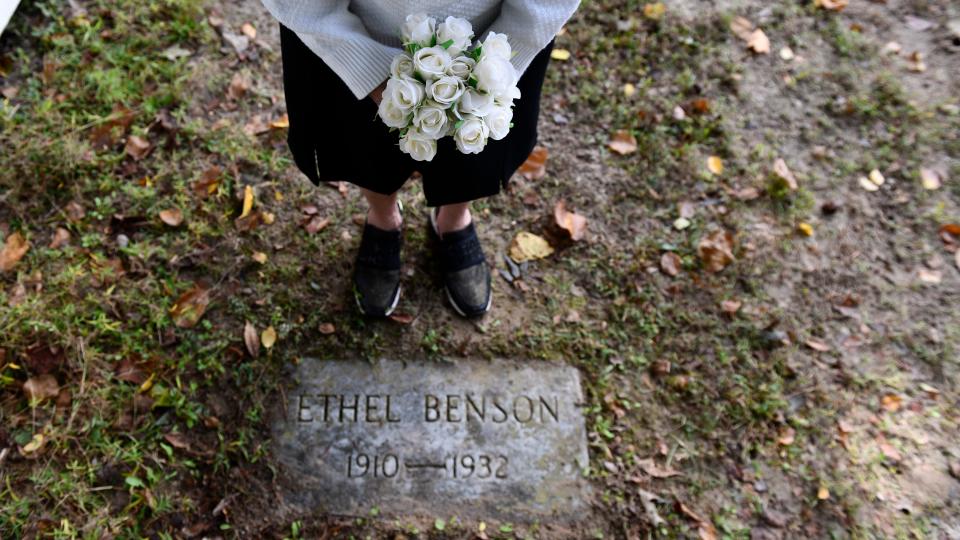
She and her daughter visited the cemetery on a recent October day. To get there, the family drove on Tarumianz Road, named after the man who championed sterilization.
At the entrance, there’s a stone arch etched with the words: “Of All God’s Children These Are The Most Innocent.” Dozens of people are buried there, their names memorialized on a large headstone in the center of the cemetery.
Ethel’s flat grave marker is the only one with any type of remembrance. The pink plastic flowers the family left from the last visit have now deteriorated. Ethel’s daughter looked at the marker, clutching the white plastic flowers and a tissue. Minutes went by before she placed them down.
Who knows when the last time someone came here. Many residents at Stockley, past and present, never have visitors, Fleetwood said. The state cemetery has now become a place where the poor or people without families can be buried.
Nearby, there are other similar flat gravestones. A woman named Lavenia. A teenage girl named Frances. They too were labeled as mentally incompetent and sterilized by Dr. James Beebe.
More innocent souls are now at rest.
This article originally appeared on Delaware News Journal: Delaware's dark, secret history of eugenics, forced sterilization
